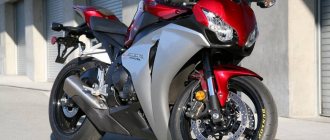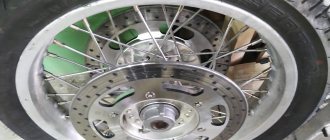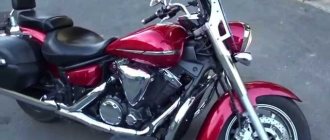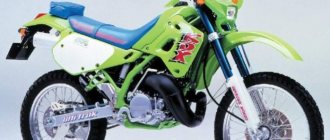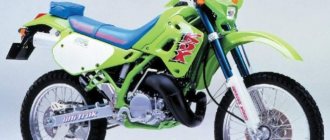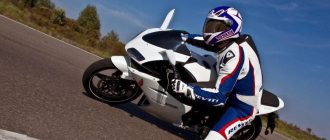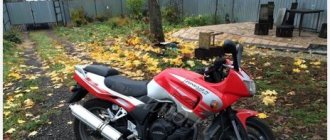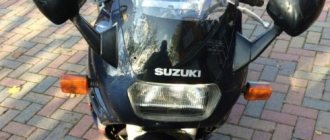In 1997, the newly launched Yamaha R1 was called “The most outrageous bike of this century.” Speaking of the 1998-1999 model, we can add that it took supersports to a new level, eclipsing the Honda FireBlade, Kawasaki ZX-9R and even the Ducati 916SPS. At that time, it had everything a modern sportbike needs, and even more.
Brief history of creation
The Yamaha R1 motorcycle dates back to the 1988 FZR1000 model, which introduced a number of major updates to the entire segment, including a lightweight aluminum DeltaBox frame, increased engine power, and a 5-valve cylinder. Improved handling and braking performance.
Then, 4 years later, an intermediate version of the CBR900RR Fireblade sports motorcycle was released, the model immediately became popular in its environment. Although it was a less powerful version of the FZR1000, it weighed less and had shorter dimensions.
It took a lot of time to finally refine the handling and dynamics of Yamaha motorcycles, so the P1 was released back in 1998.
The blue version was an incredible success among amateur racers.
Over the course of 15 years, the Yamaha R1 model has undergone significant changes, both in technical equipment and in terms of engine power. For example, in 2000, the body became more rapid and aggressive in shape, with better streamlining, increasing speed and reducing resistance.
The birth of a legend. History of the model.
At the time of birth it was the fastest motorcycle on the planet !
Up to a hundred - less than three seconds, and only seven and a half - up to two hundred. However, the bike did not become a “death capsule”, because along with such incredible speed characteristics it received excellent handling, gaining fame as a very “racer-friendly” machine. The designers managed to achieve this: firstly, by moving the bike’s center of gravity as low as possible, and, secondly, by reducing the wheelbase and increasing maneuverability.
The legendary motorcycle is already 16 years old, and during all this time its recognizable appearance has changed, if at all, not too significantly, which means it was successful from the very beginning.
The 2002 Erka differed insignificantly from the first motorcycle: an improved injection system and easy suspension upgrades. The main difference is a new, cast frame with minimal welding, which makes it more rigid.
Two years later, another model appeared, easily recognizable by its front-mounted air intakes. There were no significant changes in the design - the brakes and steering wheel were slightly modernized, equipped with a damper.
And only in 2007, the model range was replenished with a bike with a modified engine with a 4-valve arrangement per combustion chamber. However, the declared 182 “horses” look cool only on the stands. In practice, on the way to the drive wheel, 36 of them run away somewhere...
2009 was marked by the appearance of a number of improvements on the sportbike, designed not to increase speed, make cornering easier, or save a couple of milliseconds on anything else. No! Erka was equipped with several ignition maps for different weather and type of road surface. It seems that for the first time the designers of a crazy sportbike seriously, like adults, were concerned about the safety of the pilot.
The trend continued and in 2012 the Erka arrived with traction control. And here the designers were original: this bike does not have tilt angle sensors. Their function is performed by sensors located on the wheels.
Yamaha P1 technical specifications
Length – 207 cm;
Width – 71.5 cm;
Height – 113 cm;
Ground clearance – 13.5 cm;
With a total weight of 206 kg.
Engine
The engine features a MotoGP-derived crankshaft in a 998 cc inline-four. See: Uses Yamaha's exclusive crankshaft technology developed from the YZR-M1 MotoGP. Every millimeter of this unique engine is designed to deliver thrills, and for 2021 a new cylinder head, intake system, and fuel injectors will be added.
The design of the bike is made in a sporty style
The Yamaha P1 features Yamaha's new wireless Controlled Throttle (YCC-T) system, which converts rider input into motion, with a full suite of IMU-based electronic rider aids. New electronic features provide even greater control and control.
Yamaha created the first serial production product in the history of motorcycle construction with characteristics similar to those of the P1.
The Yamaha P1 clutch has a multi-plate clutch. Because of the ambidextrous quickshifter, you can change gears without pressing the clutch, which helps reduce lap times.
Capacity and power
The power of the Yamaha P1 is truly enviable; the maximum power is 147.1 kW. with a displacement in Yamaha P1 of 998 cubic meters.
Sports transmission
The 6-speed transmission perfectly matches the explosive engine, providing quick revs and optimal power and traction delivery. Japanese engineers managed to improve the weight distribution of the motorcycle due to the pyramidal arrangement of the input and output shafts of the gearbox, which made the R1 engine shorter.
You can envy the power of the Yamaha P1
Upgraded brakes
The YZF-R1 uses track brakes featuring powerful 4-piston radial front calipers, stainless steel front guides, large 320mm rotors with new high-friction pads and an all-new compact ABS unit. The new Bridgestone RS11 tires provide excellent grip and balanced road feel and handling.
Yamaha has a top-end modification with 4-piston radial calipers on the front brake. And braking accuracy is calculated by the ABS Unified Braking System, developed specifically for motorcycle racing. The system prevents the rear wheel from slipping during heavy braking and integrates with the overall IMU system when calculating the optimal loads on the brake calipers.
Fuel consumption
Fuel consumption is about 7.2 liters per 100 km.
Carburetor
The Yamaha P1 carburetor has a new fuel injection system, which increases the speed.
The price is related to the year of manufacture of the motorcycle.
Ruben Xaus & YZF-R1M
Yamaha has finally created a worthy competitor to the BMW S1000RR, Ducati Panigale 1299 and Aprilia RSV4 Factory. In fact, it is no longer possible to draw analogies between the predecessor and the new model: they are completely different and are separated from each other by a whole generation. Probably, today the YZF-R1M is the most advanced production motorcycle in terms of electronics, which even provides the ability to control lateral slips.
To be honest, it can take quite a long time to understand the many settings that the engineers generously rewarded the new product with. For me personally, it’s most convenient when all electronic assistants are turned off. Of course, this does not mean that the electronics are not working correctly. I found engine response smoother and more predictable in the lower and mid-range than the BMW S1000RR and RSV4 Factory.
True, compared to the Ducati Panigale1299, the low and medium speed zone is not so pronounced. As for the output of the power unit in extreme conditions, I believe that here the YZF-R1M is quite comparable with its Italian and German counterparts. Of course, there are also points that I would like to change a little: let’s say, after the fourth lap at MRW and the second in Belgorod, the brakes were a little tired.
It should be noted that, unlike large tracks, on a karting track there is no place for the brake discs to be cooled by oncoming air at three-digit speedometer values, which is why on short tracks or karting tracks any problem with a motorcycle with braking systems is revealed much faster.
In terms of handling, the YZF-R1M is noticeably more interesting than the BMW S1000RR, it is lighter on the switchbacks, faster in chicanes, and sometimes gives the feeling of a 600 cc sports bike rather than a heavy “liter”. I think that Yamaha managed to bring a serious competitor to the market, and now the positions of the BMW S1000RR, just a trio of “Japanese”, as well as the Aprilia RSV4 Factory, will no longer be so strong and cloudless.
Average cost of a motorcycle and annual maintenance
How much a Yamaha P1 costs is directly related to the year of manufacture of the motorcycle; the newer it is, the correspondingly higher the cost. For example, this year’s model will cost 1,800,000 thousand rubles; for older versions the price is reduced. It is also possible to buy a motorcycle through sites selling used goods, but there is a danger of running into a low-quality product, without documents, with faults, and so on.
Therefore, it is better to legally purchase motorcycles from previous years of production.
Annual maintenance of a top-end motorcycle will also not be cheap. Consumables, not counting gasoline, cost about 20,000-30,000 thousand rubles per season.
Sergey Krapukhin
Sergey, what are your first impressions of Yamaha’s flagship?
Speaking of the engine, the power delivery is very smooth, from the lowest revs to the top revs. In other words, you are always “on the moment”, there is no problem that the previous YZF-R1 had when the engine “died” at high speeds. Now the power “stretches” throughout the entire tachometer range, without hysterics or explosions.
What didn't you like?
There probably wasn't anything I didn't like.
Okay, let's formulate the question differently: what would you like to change?
I didn’t have time to try all the possible options for electronic intervention in the operation of the suspension - so far I’ve only driven with city adjustments, I also drove in the PWR1 power mode, intended for the track, while in the M1 mode it is possible to “manually” adjust the operation of the suspension hydraulics.
I analyzed the difference between the settings from A1 to A3, and still I would like to try to make the suspension work harder by working with the standard electronics. Then it will become clear whether it is worth changing to a cartridge suspension, without electronics, or perhaps this will be the first motorcycle (for professional track use) where it will be possible to stay with the electronic suspension at stock settings.
Do you think the average user will be able to understand and use the full potential of the YZF-R1M's electronics?
The electronics and algorithms for its operation and settings on the YZF-R1M are designed for any level of rider: if you don’t understand anything or don’t want to understand the myriad of capabilities of the motorcycle, then you can stay in the basic modes: any automatic program for the electronics, it doesn’t matter – PWR1, PWR2 or PWR3, in 90% of cases it will cover the capabilities and needs of the majority of future owners...
If you were to rank modern liter sportbikes, how would you rank them?
I have not ridden all modern liter sportbikes, so I can only evaluate those that I was able to test. My rating will probably look like this:
Yamaha YZF-R1M, Aprilia RSV4 Factory and BMW S1000RR.
The YZF-R1M, with its level of saturation with electronics and the possibilities of its adjustments and settings, is a different level of modern liter sportbikes. This motorcycle will always allow you to use new solutions and make you work with it. In other words, the YZF-R1M, with its endless potential, is like an unread book in which there is always something new to discover...
Main modifications of Yamaha YZF-R1
There are 3 different versions of the moto. The first is in the regular P1 configuration, the second is P1m in the more expensive track version. The main difference is the presence of a 6-piston brake. It also adds electronic suspension, an aluminum fuel tank, carbon fiber bodywork and racing tires.
The third configuration, P1c, was released in a civilian version and its cost is lower than usual. It adds aluminum wheels, steel cranks and no quickshifter, simpler tires, and slightly more torque.
General maintenance guidelines can be found in documents or manuals for the Yamaha P1.
How much does happiness cost? Average price for a motorcycle.
About 800,000 tr.
Given that happiness has no price at all - it’s not expensive, right? Why do you need a car? Four wheels are clearly too much. Sell it. Although, if you don’t go to such extreme extremes, you can surf the net and find a decent Erka at the price of, if not a used Zhiguli, then a new one – easily! On the official website of the motorcycle manufacturer you can find recommended prices and additional accessories.
The author of the article saw with his own eyes an advertisement for the sale of such a bike for 177,000 thousand, however, one can only guess about its condition, a 10 x 10 photo does not give an idea about it, but why not? If such a miracle as the Yamaha YZF R1 appeared in the world, then other miracles must happen.
Domestic motorcycles lag somewhat behind foreign ones in terms of characteristics. For example, the IZH Jupiter 5 motorcycle has a maximum speed of only 125 km/h without a sidecar.
But our snowmobiles are of fairly high quality. In our article we will analyze in detail snowmobiles from.
Now we have smoothly approached the most important and expected moment - getting acquainted with the new “Crossplane” technology and a road test drive of the Yamaha YZF-R1 2009 motorcycle. Those who are or have been interested in this motorcycle model have probably seen the inscription on the side plastic “crossplane i4 “, but no one could understand the meaning of this inscription without familiarization with the inner world (heart) of the motorcycle.
Specifications. Let's warm up before the test drive
“Born in MotoGP” – everyone understands the meaning of this word differently. The motorcycle is made using the technology of Valentino Rossi's Yamaha YZF-M1 racing motorcycle, but this does not mean that the new YZF-R1 is an exact copy of the racing bike, but it has a lot in common and it was not for nothing that it received the nickname “revolutionary”!
The motorcycle is assembled in a completely new lightweight Deltabox frame (if I’m not mistaken - the fifth generation) consisting of several aluminum alloys and having a clear shape that promotes the concentration of masses strictly in the center. The 1-in-1 monoshock and swingarm mounting design follows the design of the YZF-M1 racing motorcycle. The rear swingarm is lighter than the 2008 model. Both the front and rear suspension have many options to suit every taste. Thanks to all this, the motorcycle received clear control and handling! By the way, the short wheelbase of the new Yamaha reminds me of the KAWASAKI ZX-10R motorcycles, the shape of which I’m just crazy about.
The motorcycle received a completely new engine for its “10th anniversary of the R1 line”, manufactured using the technology of MotoGP racing motorcycles! Engine displacement is 998 cm3 with crankshaft crank pins spaced 90 degrees apart (crossplane).
The engine strokes have changed and do not follow in pairs or in a row, but with a shift of 90 degrees (270 degrees - 180 degrees - 90 degrees - 180 degrees). This makes it possible to achieve uniform torque from the engine and uniform filling of the cylinders (imitation of a V-shape). Thus, the motorcycle throttle becomes very sensitive and responsive.
Now remember the beautiful demo video from Yamaha that showed CrossPlane technology?
Maximum engine power of 133.9 kW (182 hp) is achieved at 12,500 rpm without inertial boost, and maximum torque of 115.5 Nm at 10,000 rpm. Bore is 78mm, stroke is 52.2mm and high compression ratio is 12.7:1. Engine management systems YCC-T and YCC-I YCC-T - Yamaha Chip Controlled Throttle, in a nutshell - electronic throttle control that allows you to accurately dose the mixture. YCC-I - Yamaha Chip Controlled Intake - electronic intake control that interacts with YCC-T. The systems are not new and have already found wide application in Yamaha motorcycles. There is a ton of information on the Internet.
The engine oil bath capacity is 3.73 liters according to the manual, however, 4 liters flies in there with a whistle and does not even reach the maximum.
The exhaust system of the motorcycle also received a number of changes. In addition to the changed shape of the exhaust ends from the inside, they were also changed externally, and despite their impressive massive shapes, they did not add any weight to the motorcycle. The dry weight of the motorcycle is 176 kg. The Japanese tradition of 1:1 is observed, and equipped with 206 kg.
By the way, the sound of the new eR glasses has really become different in comparison with the usual familiar “drilling” sound from private soldiers and is reminiscent of MotoGP racing cars, but somewhat quiet. This is not surprising, because the motorcycle was created for public roads!
Without delay, we set about remaking the exhaust system, because... The direct-flow system increases the power characteristics of the motorcycle, and also opens up a new angry sound compared to the stock version. Later we removed the catalyst from the exhaust system - now the straight-through exhaust is nowhere :)!
In the last part I forgot to mention a nice little innovative detail about the motorcycle headlights. They are equipped with electromagnetic curtains and the firing range of the light beam is adjusted precisely thanks to them.
As a result, we got a motorcycle with a direct-flow exhaust system, new oil after breaking in the motorcycle (in turn, the motorcycle came to life on it even more), an improved braking system and new Kevlar EBC clutch discs, which I have not yet written about on the site, but I'll fill this gap later.
We can talk about theory endlessly, but let’s move away from all this and get down to test driving on public roads and racing.
The first 250 km of riding this motorcycle will forever remain unforgettable for me. Looking at the dimensions of the motorcycle, it was scary to get on it. The throttle handle, even in medium STD mode, responds to touch instantly. The ride is very comfortable. The motorcycle picks up speed impressively, predictably and evenly - this is the first thing that was felt and pleasantly pleased. There are no sudden, unpredictable pick-ups at high speeds - the traction is uniform throughout the entire speed range! This contributes to lightning-fast acceleration from a standstill, and in the city, as you understand, traction from the bottom is much better appreciated than at the top, which you rarely feel in a dense stream of cars.
The steering damper, which is electronic in this version, works and justifies itself with a bang during intense acceleration, but at low speeds it is not felt and thoughts arise to install an additional rotary one. After riding the motorcycle (more or less), I eventually switched to “A” mode. The most powerful and “turretless” mode of this motorcycle. On the Internet I often come across articles where they write that the new R1 is soft! This is wrong! It is very sharp, clearly reacting to the slightest touch of the pilot on the throttle, with crazy traction (I’m not talking about turns, where even in second gear you can draw long stripes on the asphalt with rubber).
In “A” mode, when accelerating at full throttle, the motorcycle simply flies up onto the rear wheel and, when quickly shifting into second gear, continues to move in an aggressive stance! Riding a motorcycle is also not difficult. It clearly lends itself to manipulation, either from the throttle or from the clutch. Moreover, if you release the clutch smoothly, it gets up smoothly, without a jerk - indescribable delight! It's time to compete with our local guys on the 2007 Honda CBR1000RR Pulya Seryoga and Valerka Litrovich. Well, the guys there are pros. God forbid everyone will deface their own on motorcycles. No matter how hard I tried to overtake over short distances, nothing worked. Spectators said that I had little experience with a sharp start from a standstill, although from a standstill I pulled ahead and after that the Honda overtook me without giving me any chance :). Later we arrived with a SUZUKI B-king 1300cc, which was also a serious struggle. Out of approximately 20 races, I managed to come first 1 time. In general, the excitement and loss of fear for driving at full throttle does not disappear immediately, and after riding and getting used to it, you can compete with an adult.
In the video, the motorcycle is without modifications, except for the exhaust of our second version. The video is one of the first; I had no experience with the new motorcycle.
The third test was with our champion, an old Kava 10 years ago, 900 cc, which tore all three of us :). Our friend Vadik, who has been involved in motocross all his life, is driving. And if with Honda and Suzuki there was still a chance of winning, then with Kawasaki there was no chance.
One way or another, everyone who saw the motorcycle was pleased with it. Next season I plan to ride the motorcycle and try to compete with the guys more than a dozen times in Tsyurupinsky Qatar :). In any case, I didn’t feel a fantastic advantage over my rivals when accelerating in a straight line, but this does not mean for me personally that the motorcycle is G... I’m sinning due to my inexperience.
Design
In the case of the Yamaha R1, the photo does not convey all the grace of the motorcycle. A swift silhouette, born after numerous aerodynamic tests, a predatory squinting of the headlights... It seems that the bike is not driving along the road, but is flying over it. Perhaps this is so, if you remember what speed he is capable of developing. Over the past twenty-odd years, it has changed noticeably in appearance, but both old and new Yamaha P1s look very stylish .
FAQ
- What is the maximum speed of the bike? 300 km/h for the latest generations, and a little less for the first.
- What kind of gasoline should I use? Carburetor versions can use 95. It’s better to fill the injection ones with 98, although the bike can also work on pure 95, but it’s better not to take risks.
- How many cubes are there in it? Thousand? No, the engine volume has never changed - 998 cc.
- In what year did they start installing injectors? In 2002.
- Is it heavy? Does it have a lot of weight? I had a cruiser that weighed 350kg, can I handle a Yamaha R1? Subjectively, the motorcycle does not seem heavy, but it weighs about 200 kg, give or take, depending on the generation.
Chassis and brakes
The brakes of this model are good: at the rear there is a 220 mm disc with a single-piston caliper, and at the front there are a pair of 320 mm discs with four-piston radial calipers. The rear swingarm, like the front inverted fork, has all adjustments and a stroke of 120 mm.
Owner reviews
It was the Yamaha P1 that showed me where adrenaline comes from)) After the meeting with the seller, I took the bike and went home, I had never experienced such sensations in my life. At first it was scary to drive around the city; turn the handle sharply 1/5, and there is a risk of flying into a pole or car. The motorcycle is crazy, I'm delighted. Dmitry, Moscow.
I switched from the CBR 600, which was the second of my three sports, I didn’t want to change my beloved Honda, but I fell in love with Erku at first sight. The characteristics are crazy, the comfort is so-so, but it looks so that the number of passers-by turning their heads at it is in the dozens every day, and these are only those whom I myself notice. R1 is the king of sportbikes! Sergey, Krasnodar.
At first I drove a 1998 YUZF R1, the motor I received was damaged, a month later the motor died - the valves were bent. I used it for spare parts, and for the next season I bought the same one, but 2008. It feels like you’re sitting on the same motorcycle, only the instrumentation has become prettier, and the character of the engine has become more friendly, not so harsh, smart electronics prevent you from making a mistake. But the power hasn’t gone away, the acceleration is such that it pulls you back across the seat. Vasily, St. Petersburg.
Advantages and disadvantages
To produce the YZF R1, Yamaha used all the technologies available to it, so the disadvantages of the sportbike stem from its advantages.
Advantages
- Crazy acceleration dynamics . Not a single ultra-expensive sports car can compare with the Yamaha P1 in this regard.
- Great brakes . They have become a real standard in the world of motorcycles.
- Stylish and recognizable design . Even those bikers who have never ridden anything other than a Ural know what this model looks like.
- Refined handling . This is especially noticeable on the track.
Flaws
- Engines on first-generation specimens are prone to oil starvation if their horizon changes, so the motorcycle is not very suitable for a stunt.
- At the bottom the bike behaves nervously, reacting sharply to the slightest change in the throttle position.
- It is not easy to maintain and repair modern YZF-R1s yourself, and all operations at dealers are expensive.
